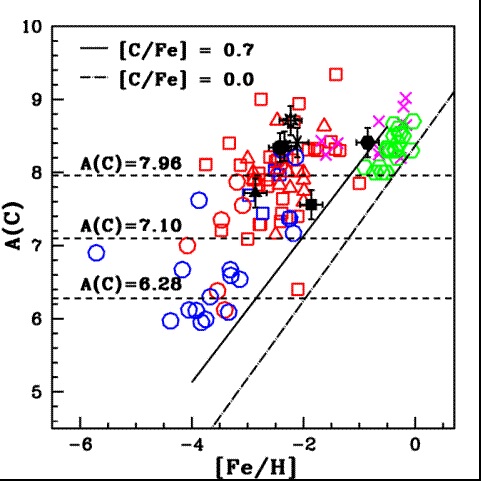Ministry of Science & Technology
Carbon-rich stars steal heavy elements from their low mass companions
प्रविष्टि तिथि:
31 DEC 2021 2:57PM by PIB Delhi
Scientists have long been intrigued by the presence of much higher fraction of elements heavier than iron than is expected in carbon-rich stars. A new research by Indian astronomers has now traced its origin to the low mass companions of these stars, from which the materials have been stolen.
Though there has been significant progress in understanding the formation and evolution of several chemical elements and their isotopes in the Universe, the origin and evolution of heavy elements, that is, elements heavier than iron, in the Universe is far from being clearly understood.
A group of astronomers from the Indian Institute of Astrophysics, Bengaluru, an autonomous institute of the Department of Science & Technology, Govt. of India led by Prof Aruna Goswami and her doctoral students Meenakshi P. and Shejeelammal J. at IIA have analyzed the surface chemical composition of several Carbon Enhanced Metal-Poor (CEMP) stars and have achieved a significant advancement in unraveling this puzzle. This work has been published in ‘The Astrophysical Journal’ recently.
CEMP stars are characterized by diverse heavy elements abundance patterns and are primarily classified into four groups, based on which groups of heavy elements are more abundant. These are mostly dwarf stars, sub-giant stars, or giant stars, and stars that belong to these evolutionary stages cannot produce elements heavier than iron.
“At the evolutionary stages in which the stars exist, they are not expected to produce heavy elements. However, the surface chemical composition of these stars exhibit abundances of heavy elements those are about 100 to 1000 times higher than that of the Sun. So, we looked for the origin of the observed enhanced abundances of the heavy elements, deriving possible clues from the stellar surface chemical abundance signatures,” Prof. Goswami explained.
The team analyzed high quality, high-resolution spectra of the stars acquired using 2-m Himalayan Chandra Telescope (HCT) at the Indian Astronomical Observatory, Hanle, 1.52-m Telescope at the European Southern Observatory at La Silla, Chile, and the 8.2-m SUBARU Telescope at the summit of Maunakea, Hawaiʻi, operated by the National Astronomical Observatory of Japan, to resolve this puzzle.
They used elemental abundance ratios of certain key elements such as carbon, magnesium, strontium, barium, europium, lanthanum, etc., as diagnostics that gave important clues to the origin of the enhanced abundances.
In two recent papers, both published in the Astrophysical Journal, they have shown that the enhanced heavy elements observed in the CEMP stars are actually produced by their low-mass stellar companions in a phase of evolution called Asymptotic Giant Branch (AGB) and transferred the products to the CEMP stars through various mass transfer mechanisms. The low-mass companions have further evolved to white dwarfs that are no longer detectable. The scientists employed a set of classification schemes and used spectroscopic techniques to examine if the stars show variability in radial velocity and found that most of the stars are indeed binaries.
“Analysis have provided further support and confirmed that the companions are of low-mass and also of low-metallicity.” Shejeelammal and Meenakshi pointed out.
Publication link:
- https://doi.org/10.3847/1538-4357/ac1ac9
- https://doi.org/10.3847/1538-4357/ac1d4d
For more information, Contact: Ms Meenakshi P (Email:meenakshi.p[at]iiap[dot]res[dot]in), Shejeelammal J (Email: shejeelammal@iiap.res.in), Prof. Aruna Goswami (Email:aruna[at]iiap[dot]res[dot]in).

High resolution (upper panel) and low resolution (lower panel) spectra of some of the stars. Neutral and singly ionized lines due to some elements such as iron (Fe), magnesium (Mg), and titanium (Ti) can be seen in the upper panel, and Carbon molecular bands due to CH and C2 are strongly visible in the lower panel.

The locations of known CEMP stars in a plot of relative abundance of iron (x-axis) versus that of Carbon (y-axis). The various coloured symbols mark the various types of CEMP stars. The stars from this study are in black, with a cross on them, and their location in this diagram implies that these are binary stars, with a companion.
*****
SNC / RR
(रिलीज़ आईडी: 1786553)
आगंतुक पटल : 1044